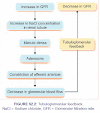Antibiotics resistance:
Antimicrobial or antibiotic resistance simply means the resistance shown by the microorganism to the pharmacological action of the antibiotics.
Antimicrobial or antibiotic resistance is a threat to public health and patient safety.
Nowadays infections with antibiotics resistant microorganism are associated worldwide with increased morbidity and mortality. Because of antibiotics resistance, the treatment choices against a microbe is greatly diminished. Resistance to antibiotics may not necessarily develop under all conditions.
· Misuse of antibiotics (taking antibiotics for a pathogen which is not under its spectrum or making unnecessary use of antibiotics under common nonpathogenic ailments).
· Inadequate use of antibiotics.
· Premature therapy termination.
· Taking lower dose than required
Antibiotics should be rationally utilized because of the possibility of resistance development to them.
Types of antibiotic resistance:
Antibiotic resistance can be categorized into two main divisions;
1. Natural antibiotic resistance
2. Acquired antibiotic resistance
Natural antibiotic resistance:
Natural antibiotic resistance is not a big problem. For example, an antibiotic that is cell wall synthesis inhibitor won’t have any lethal effects on mycoplasma, because mycoplasma doesn’t have any cell wall.
To cop up with natural antibiotic resistance we just need to administer the proper antibiotic for a specific pathogen.
Acquired antibiotic resistance:
Acquired antibiotic resistance is that in which the pathogen acquire antibiotic resistance due to improper antibiotic use and the resistance develops under certain mechanisms.
Acquired antibiotic resistance is a serious problem and needs special attention. Because a pathogen which is resistance to antibiotic for a certain dosage won’t be eradicated under any conditions at the same dose, instead a higher dose of that antibiotic, or an antibiotic of another class would be required for its treatment. Moreover, if a pathogen is resistant to a certain drug then shifting to another drug in the same antibiotic class is useless because both are following a general mechanism which is common for both of them.
Mechanism of antibiotics resistance development:
A pathogen may develop resistance, by any of the mechanisms given below;
· Beta-lactamase production: beta-lactamase is a class of enzymes that bring about the hydrolysis of beta-lactam ring in beta-lactam antibiotics. For each member of beta-lactam antibiotics, there is a specific beta-lactamase, for example, penicillinase is for penicillin, cephalosporins is for cephalosporin and other extended-spectrum beta-lactamases. For pathogens which are able to proceed with beta-lactamase formation, beta-lactam antibiotics are not suitable.
· Decreased permeability to beta-lactams: certain bacteria are able to get resistant to antibiotics by decrease cell membrane permeability for those antibiotics. This is an issue with beta-lactams in a majority of conditions.
· Efflux pump development: certain bacteria are able to develop an efflux pump within their cell membrane that actively transports antibiotics such as tetracycline from their cell body, thus avoids its therapeutic effect. Efflux pump development is the primary mechanism of antibiotics resistance with tetracyclines antibiotics.
· Alteration of binding sites: binding sites or target sites or those receptor zones inside the pathogen where an antibiotic must attach itself in order to kill the bacteria. If the pathogen brings structural changes in its geometry the attachment site of antibiotic will no more result in lysis of bacteria and thus an antibiotic resistance develops. This is a secondary mechanism of penicillin resistance cases.
· Enzymatic degradation of antibiotics: transferases are enzymes which can degrade penicillin by oxidizing it to penicillanic acid thus destroying its therapeutic capabilities. With aminoglycosides and chloramphenicol, this type of resistance often develops.



